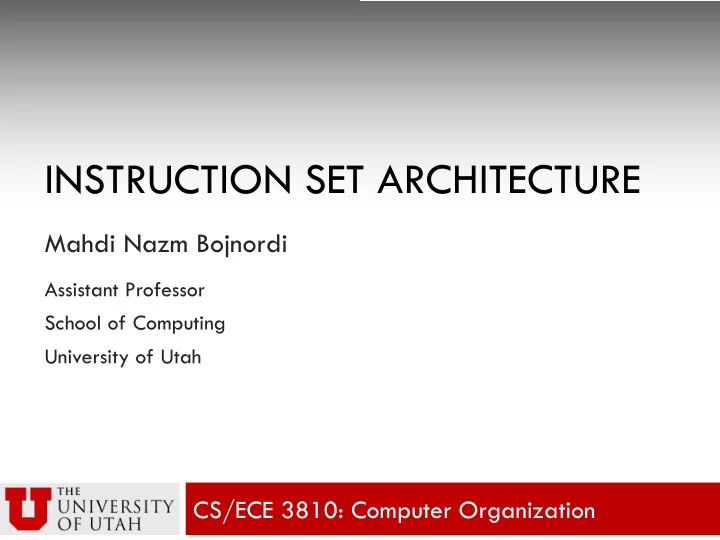

INSTRUCTION SET ARCHITECTURE Mahdi Nazm Bojnordi Assistant Professor School of Computing University of Utah CS/ECE 3810: Computer Organization
Overview ¨ This lecture ¤ Instruction Operands ¤ Registers ¤ Basics of Memory ¤ Memory Access Instructions
Recall: Example MIPS Instruction ¨ Translate this one f = (g + h) – (i + j); ¨ Assembly add f, g, h add t0, g, h sub f, f, i add t1, i, j sub f, f, j sub f, t0, t1 ¨ In summary ¤ operations are not necessarily associative and commutative ¤ More instructions than C statements ¤ Usually fixed number of operands per instruction
Operands ¨ In a high level language, each variable is a location in memory ¨ You may define a large number of operands (variables) in a high-level program ¨ The number of operands in assembly is fixed (registers) CPU Bus Memory
Registers ¨ To simplify hardware, let’s require each instruction (add, sub) only operate on registers ¨ For example CPU Registers ALU ¤ MIPS ISA has 32 registers ¤ x86 has 8 registers ¨ 32-bit registers Bus ¤ Modern 64-bit architectures Memory ¨ Every 32-bit stores a word
Register File ¨ A set of registers in the processor core ¤ An index is used to identify each register RF add a, b, c 0 1 add $3, $4, $1 2 3 4 $3 ß $4 + $1 5 6 ¨ For more readability + ¤ registers are partitioned as $s0-$s7 (C/Java variables), $t0-$t9 (temporary variables)…
Memory Access ¨ Values must be fetched from memory before (add and sub) instructions can operate on them read/write address ¨ Memory operations data ¤ Read n Returns data stored at location address Memory ¤ Write n Stores data at location address
Memory Access ¨ Values must be fetched from memory before (add and sub) instructions can operate on them CPU read/write ¨ Load word address data ¤ lw $t0, memory-address ¨ Store word ¤ sw $t0, memory-address Memory ¨ How is memory-address determined?
Memory Address ¨ The compiler organizes data in memory… it knows the location of every variable (saved in a table)… it can fill in the appropriate mem-address for load-store instructions int a, b, c, d[10] Memory
Memory Address ¨ The compiler organizes data in memory… it knows the location of every variable (saved in a table)… it can fill in the appropriate mem-address for load-store instructions int a, b, c, d[10] Memory Base address
Memory Address ¨ Each word is referred to with the address of a single byte int a, b, c, d[10] Memory à c = 8163 (00000000 00000000 00011111 11100011) bin
Memory Address ¨ Each word is referred to with the address of a single byte int a, b, c, d[10] Memory à c = 8163 (00000000 00000000 00011111 11100011) bin à (00 00 1F E3) hex = 0X00001FE3
Memory Address ¨ Each word is referred to with the address of a single byte ¤ Big Endian 00 00 1F E3 n MIPS, IBM 360/370, x n Motorola 68k, Sparc, x+1 x+2 x+3 n HP PA, ARMv8 Memory à c = 8163 (00000000 00000000 00011111 11100011) bin à (00 00 1F E3) hex = 0X00001FE3
Memory Address ¨ Each word is referred to with the address of a single byte ¤ Little Endian 00 00 1F E3 n Intel x86, DEC VAX x n DEC Alpha x+1 x+2 x+3 Memory à c = 8163 (00000000 00000000 00011111 11100011) bin à (00 00 1F E3) hex = 0X00001FE3
Recommend
More recommend